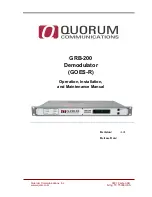
Page 18-36
Rejecting a true hypothesis, Pr[Type I error] = Pr[T
∈
R|H
0
] =
α
Not rejecting a false hypothesis, Pr[Type II error] = Pr[T
∈
A|H
1
] =
β
Now, let's consider the cases in which we make the correct decision:
Not rejecting a true hypothesis, Pr[Not(Type I error)] = Pr[T
∈
A|H
0
] = 1 -
α
Rejecting a false hypothesis, Pr[Not(Type II error)] = Pr [T
∈
R|H
1
] = 1 -
β
The complement of
β
is called the power of the test of the null hypothesis H
0
vs. the alternative H
1
. The power of a test is used, for example, to determine
a minimum sample size to restrict errors.
Selecting values of
α
and
β
A typical value of the level of significance (or probability of Type I error) is
α
= 0.05, (i.e., incorrect rejection once in 20 times on the average). If the
consequences of a Type I error are more serious, choose smaller values of
α
,
say 0.01 or even 0.001.
The value of
β
, i.e., the probability of making an error of Type II, depends on
α
, the sample size n, and on the true value of the parameter tested. Thus, the
value of
β
is determined after the hypothesis testing is performed. It is
customary to draw graphs showing
β
, or the power of the test (1-
β
), as a
function of the true value of the parameter tested. These graphs are called
operating characteristic curves or power function curves, respectively.
Inferences concerning one mean
Two-sided hypothesis
The problem consists in testing the null hypothesis H
o
:
µ
=
µ
o
, against the
alternative hypothesis, H
1
:
µ≠ µ
ο
at a level of confidence (1-
α
)100%, or
significance level
α
, using a sample of size n with a mean
x and a standard
deviation s. This test is referred to as a two-sided or two-tailed test. The
procedure for the test is as follows:














































